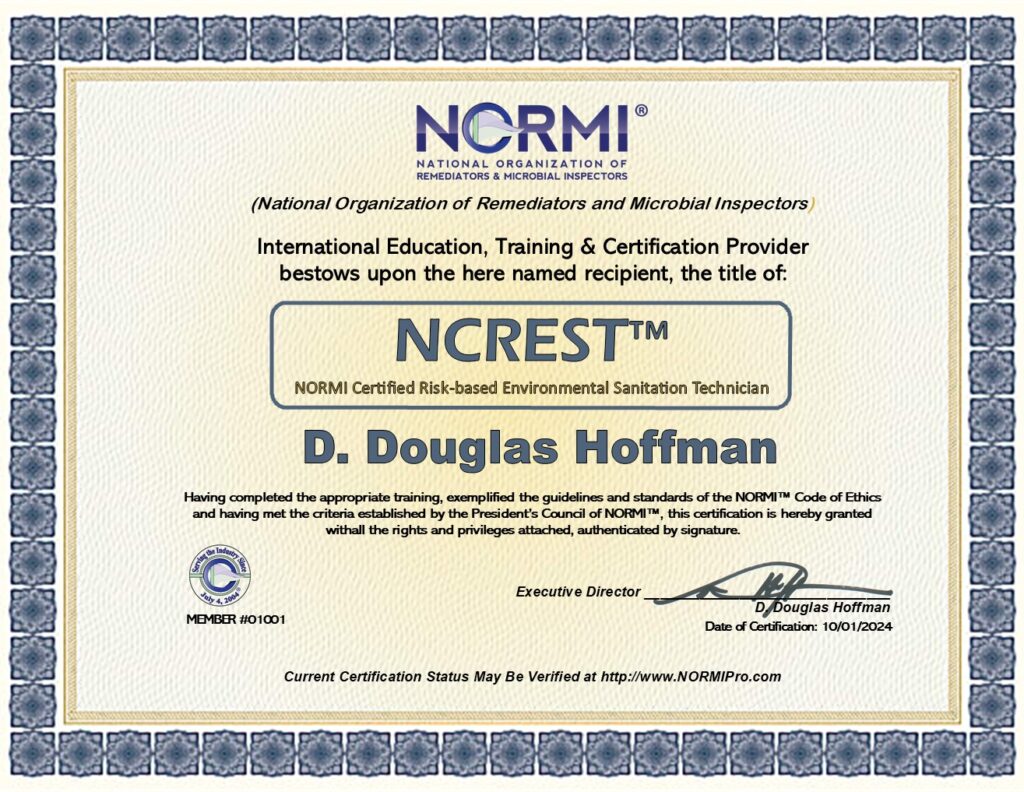
🛡️ NCREST™ Certification
Protecting Health Through Smarter Cleaning
The NCREST™ certification program equips front-line cleaners, facility maintenance personnel, and restoration contractors with the essential knowledge and practical skills to perform risk-based environmental sanitation.
Unlike traditional cleaning courses, NCREST™ focuses on how and why cleaning decisions matter for health outcomes. Participants learn to identify invisible risks in the built environment, control reservoirs where germs thrive, and apply proven infection-prevention practices.
With a clear emphasis on fine-particle cleaning, this training empowers professionals to go beyond surface appearances — protecting building occupants, staff, and communities from infectious risks.
Graduates of NCREST™ gain more than a certificate: they earn a trusted, trademarked credential that demonstrates their expertise, credibility, and commitment to health-centered cleaning.
Why NCREST™ Matters
✔ Recognized, trademarked certification from NORMI™
✔ OSHA-aligned infection control practices
✔ Risk-based approach, not just routines
✔ Marketable skills that elevate professional credibility

About the NCREST™ Course
The NCREST™ certification program is designed for professionals who do more than clean — they protect health. Rooted in OSHA standards and the latest infection-prevention science, this course takes participants beyond checklists and routines to master risk-based environmental sanitation.
Through a blend of practical strategies and real-world scenarios, participants learn to identify hidden reservoirs where germs thrive, understand how they spread, and apply targeted cleaning and disinfection methods. Special emphasis is placed on fine-particle cleaning, giving front-line cleaners, facility staff, and restoration contractors the confidence to stop contamination at its source.
Graduates of NCREST™ leave with a nationally recognized, trademarked certification that demonstrates credibility, expertise, and a commitment to safeguarding indoor environments. Whether you’re maintaining a school, hospital, office, or restoration site, NCREST™ sets you apart as a professional who cleans with health in mind.
ONSITE COURSES
LIVE ONLINE COURSES
STATIC ONLINE COURSES
Sign up for the NORMI™ Certified Risk-based Environmental Sanitation Technician Online Course
- Front-line cleaners and janitorial staff
- Facility maintenance personnel
- Sanitization, remediation, and restoration contractors
- Anyone responsible for controlling contamination and improving indoor health
📘 NCREST™ Course Outline
Module 1 – Recognizing Risk in the Cleaning Industry
- Defining hazards, reservoirs, pathways, and risk
- Why cleaning for health is different than cleaning for appearance
- How to anticipate and prevent infection risks in daily tasks
- Case examples: common workplace scenarios
Module 2 – How Germs Spread and Make People Sick
- The five elements of germ spread: reservoir, pathway, host, bypassing defenses, survival
- The four main pathways germs use to spread: touch, inhalation, splashes/sprays, breaks in skin
- Identifying weak points for intervention
- Infection control strategies that interrupt transmission
Module 3 – Reservoirs in the Human Body
- Skin, gastrointestinal system (“gut”), respiratory system, blood/fluids
- How these reservoirs interact with the environment
- Risk scenarios: cuts, contact, coughs, contamination
- Targeted sanitation practices
Module 4 – Reservoirs in the Built Environment
- Water and wet surfaces (sinks, drains, ice machines)
- Dry surfaces (floors, handrails, counters, curtains)
- Dirt and dust (maintenance, construction, restoration settings)
- Shared equipment (mops, cloths, carts, vacuums)
- Airborne risks (droplets, fine particles)
- How to prioritize cleaning based on risk level
Module 5 – OSHA Standards and Worker Safety
- Bloodborne Pathogens Standard (29 CFR 1910.1030)
- Hazard Communication Standard (29 CFR 1910.1200)
- PPE and Respiratory Protection Standards
- Employer and employee responsibilities under OSHA
Module 6 – Practical Sanitation Strategies
- Cleaning vs. disinfecting – why order matters
- Fine-particle cleaning for remediation and restoration
- Proper hand hygiene, PPE use, and equipment handling
- Step-by-step scenario-based exercises
Capstone Activity – Risk-Based Cleaning Scenarios
- Group exercises applying knowledge to real-world contamination risks
- Identifying reservoirs and pathways in workplace case studies
- Choosing effective intervention strategies
Assessment & Certification
- Pre- and post-training knowledge evaluation
- Practical competency exercises
- Award of NCREST™ Certification upon successful completion
